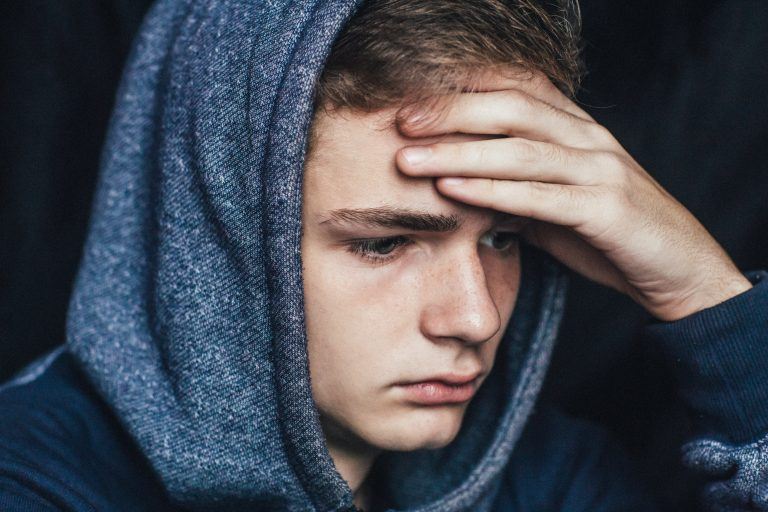Supporting Student Wellness
Focusing on Mental Health
Many individuals living with mental illness begin to experience symptoms early in life. The National Alliance on Mental Illness estimates that 1 in 6 U.S. youth aged 6-17 experience a mental health disorder each year. So in a classroom of 25 students, more than 4 of them may be struggling with mental illness. These difficulties can create significant barriers to school success and learning. In reality, undiagnosed or untreated mental health conditions can affect a young person’s ability to learn, grow, and develop. Our hope is that families, communities, teachers, school administrators, counselors, social workers, psychologists, nurses, and staff can collaboratively come together to identify and support students in need to promote student wellness in an effort to enhance social, emotional, and academic success and well-being.
Suicide Prevention
RECOGNIZING WARNING SIGNS
Some warning signs may help you determine if someone you know is at risk for suicide, especially if the behavior is new, has increased, or seems related to a painful event, loss, or change. These may include:
Negative view of self
Sense of hopelessness or no hope about the future
Isolation or feeling alone
Aggressiveness and irritability
Loss of interest
Withdrawing from activities
Making suicide threats
Increased use of alcohol or drugs
Giving things away
Engaging in risky behaviors
Sleeping too much or too little
Self -injury
Frequently talking about death
Drastic changes in mood and behavior
Feeling like a burden to others

For more information on Warning Signs, visit: The American Foundation for Suicide Prevention
Here is another source to help warning signs.
IDENTIFYING RISK FACTORS
Risk Factors are characteristics that make it more likely that someone will consider, attempt, or die by suicide. They cannot cause or predict a suicide attempt, but they’re important to be aware of. These may include:
Previous suicide attempts
History of substance use
Relationship problems
Access to harmful means
Physical disability or illness
Losing a friend or family member to suicide
Ongoing exposure to bullying behavior
Mental health condition
Recent death of a family member or close friend
STRENGTHENING PROTECTIVE FACTORS
Protective factors are personal or environmental characteristics that help protect people from suicide. These may include:
Parent connectedness
Connections to other non-parental adults
School safety and stability
Closeness to caring friends
Overall resilience
Neighborhood safety and stability
Awareness of and access to local health services
Acceptance
Skills in problem solving and conflict resolution
SEEKING HELP
If you are in a state of distress, reaching out is the first step to safety. Tell someone you trust how you are feeling. If you aren’t sure who you can talk to, click on the links below to be taken to dedicated crisis services.






How to Talk to Someone Who May be Struggling
The American Foundation for Suicide Prevention provides helpful guidelines for talking to someone who may be at risk. If you think someone is thinking about suicide, assume you are the only one who will reach out. Here’s how to talk to someone who may be struggling with their mental health:
Talk to them in private
Listen to their story
Tell them you care about them
Ask directly if they are thinking about suicide
Encourage them to seek treatment or to contact their doctor or therapist
Avoid debating the value of life, minimizing their problems or giving advice
Tell a trusted adult
If someone says they are considering suicide:
Take the person seriously
Stay with them
Tell a trusted adult
Call the National Suicide Prevention Lifeline: 1-800-273-8255
Text “TALK” to 741741 to text with a trained crisis counselor from the Crisis Text Line for free 24/7
Escort them to mental health services or an emergency room
Depression
WHAT IS DEPRESSION?
Depression is more than just feeling down or having a bad day. When a sad mood lasts for a long time and interferes with normal, everyday life, you may be depressed. Symptoms of depression vary from person-to-person, but there are some common signs and symptoms:
Feelings of helplessness and hopelessness
Loss of interest in daily activities
Feeling irritable, easily frustrated, or restless
Having trouble falling asleep or staying asleep
Loss of energy
Unexplained aches and pains
Changes in appetite or weight
Trouble focusing, making decisions, or remembering things
Feeling guilty, worthless, or helpless

SEEKING HELP
Many helpful treatments for depression are available. Treatment for depression can reduce symptoms and provide relief. Treatment can include psychotherapy and/or medication. Your doctor or a qualified mental health professional can help you determine what treatment is best for you.
GETTING HELP IN A CRISIS
Some individuals who are depressed may think about hurting themselves or taking their own life. If you or someone you know is having thoughts about hurting themselves or considering suicide, please seek immediate help. Call 1-800-273-TALK (8255) to speak to a 24/7 crisis center or dial 911.
Anxiety
WHAT IS ANXIETY?
Anxiety is a normal reaction to danger. It triggers the body’s automatic fight-or-flight response that protects us when threatened, pressured, or faced with a challenge. Anxiety is not necessarily a bad thing! It allows us to stay alert, focused, and can spring us into action. However, when anxiety is constant or overwhelming—when worries and fears interfere with our relationships and routine—it may be time to seek help. In addition to the primary symptom of excessive and irrational worry and fear, other common symptoms of anxiety may include:
Feeling tense
Irritability
Watching for signs of danger
Anticipating the worst
Feelings of apprehension
Pounding heart
Sweating
Headaches
Muscle tension
Shaking or trembling
insomnia

SEEKING HELP
Anxiety disorders respond very well to therapy. The specific treatment approach depends on the type of anxiety disorder and its severity. But in general, most anxiety disorders are treated with therapy, medication, or some combination of the two.
Coping Skills
COPING SKILLS DEFINED
Coping skills are the strategies that we use to adjust to the stresses, changes, and conflicts we encounter in life. They help us to better manage and navigate painful or difficult emotions.
HELPFUL COPING SKILLS
Physical activity or exercise
Mindfulness
Meditation
Draw
Paint
Listen to music
Talk to loved ones
Hike
Write
Photography
Play an instrument
Dance
Sing
Play a game
Clean or organize your environment
Read
Watch a funny video
Serve someone in need
Play with a pet
Make a gratitude list
Write a list of goals

Self-Care
SELF-CARE DEFINED
Self-care encompasses activities that we do deliberately to attend to and take care of our mental, emotional, and physical health.

BENEFITS OF SELF-CARE
Self-care reduces the negative effects of stress
Self-care helps you refocus
Self-care helps you be a better student
Self-care prevents burnout
TYPES OF SELF-CARE
Emotional self-care: activities that help you connect, process, and reflect on a full range of emotions.
Examples: seeing a therapist, writing in a journal, creating art, playing music, etc.
Practical self-care: tasks you complete that fulfill core aspects of your life in order to prevent future stressful situations
Examples: creating a budget, learning a new skill, organizing your closet, etc.
Physical self-care: activities you do that improve the well-being of your physical health
Examples: taking a walk, sleeping eight hours a night, staying hydrated, etc.
Mental self-care: any activity that stimulates your mind or your intellect
Examples: Reading a book, solving a puzzle, going to a museum, etc.
Social self-care: activities that nurture and deepen the relationships with loved ones and friends in life.
Examples: calling your mom, spending time with friends, going to family dinner, etc.
Spiritual self-care: activities that nurture your spirit and allow you to think bigger than yourself. This does not have to be religious, although it is for some.
Examples: meditation, yoga, going to a place of worship, dedicating time for self-reflection, etc.
WORKSHEETS
Resources
W. A. Y. Kind is a club for students and staff to collaborate about school wide wellness. Specifically, focusing on the elements of the acronym; WAY.
Wellness: Exploring and maintaining personal wellness related to the mind-body connection. Showing respect for our bodies through the choices we make and learning to make safe and healthy decisions.
Acceptance: Being open to other opinions, views, and beliefs by showing respect and support for others, even if there are differences in beliefs and views.
You: The personal accountability each individual has for creating their own wellness and how we each contribute to the general wellness of the school community.
WAY Kind Club helps organize and develop multiple school-wide positive messaging campaigns throughout the year, focusing on kindness every step of the W. A. Y.
COMMUNITY RESOURCES
HELPFUL APPS







